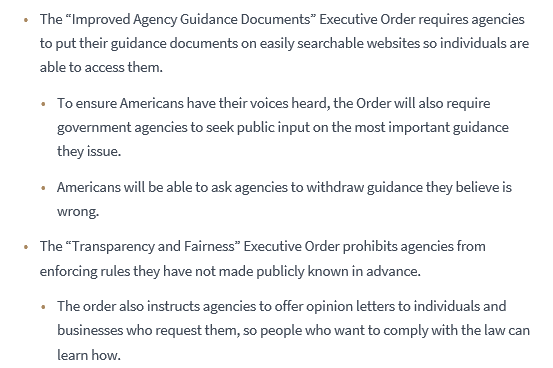Breaking News: Two Major Executive Orders
President Trump today issued two new executive orders on administrative law: The “Promoting the Rule of Law Through Improved Agency Guidance Documents” E.O. and the “Rule of Law Through Transparency and Fairness in Civil Administrative Enforcement and Adjudication” E.O.
Here is a snippet from the White House’s fact sheet:
There is a lot in these executive orders.
For example, under the “Improved Agency Guidance” E.O., “each agency or agency component, as appropriate, shall establish or maintain on its website a single, searchable, indexed database that contains or links to all guidance documents in effect from such agency or component,” and “shall note” on that website “that guidance documents lack the force and effect of law, except as authorized by law or as incorporated into a contract.” If the Office of Management and Budget asks for it, “an agency head shall submit a report to the Director with the reasons for maintaining in effect any guidance documents identified by the Director,” which report will be given to the President. And for “significant guidance documents,” review by OIRA is required and agencies must use notice-and-comment procedures. There are exceptions set out in the E.O., and additional instructions from OMB will be forthcoming. So we will see how it is enforced and applied. But on its face, this appears significant.
Under the “Transparency and Fairness” E.O., “[n]o person should be subjected to a civil administrative enforcement action or adjudication absent prior public notice of both the enforcing agency’s jurisdiction over particular conduct and the legal standards applicable to that conduct.” This means no “unfair surprise,” which is defined as “a lack of reasonable certainty or fair warning of what a legal standard administered by an agency requires,” a principle that “should be informed by the examples of lack of fair notice discussed by the Supreme Court in Christopher v. SmithKline Beecham Corp., 567 U.S. 142, 156 & n.15 (2012).” As far as I can tell, this applies to making policy through agency adjudication generally, whether or not guidance documents are involved. But the E.O. also discusses guidance documents explicitly, ordering that “[g]uidance documents may not be used to impose new standards of conduct on persons outside the executive branch except as expressly authorized by law or as expressly incorporated into a contract,” so if “an agency takes an administrative enforcement action, engages in adjudication, or otherwise makes a determination that has legal consequence for a person, it must establish a violation of law by applying statutes or regulations.” Again, there is a lot more in the E.O., including exceptions.
This is not the first time that the Administration has addressed regulatory reform, including these topics. Most notably, the Department of Justice also already taken steps to limit use of guidance documents, including through the “Sessions Memo” in 2017 and the “Brand Memo” in 2018. Today’s E.O.s seem to build on those efforts.
Finally, if you are interested, the Administrative Conference of the United States (of which I’m a public member, although I’m obviously writing here in my private capacity) has also issued recommendations on guidance documents. For instance, the Conference has recommended that “[a]gencies should maintain a page on their websites dedicated to informing the public about the availability of guidance documents and facilitating access to those documents,” and further that agencies “should not use a policy statement to create a standard binding on the public, that is, as a standard with which noncompliance may form an independent basis for action in matters that determine the rights and obligations of any member of the public.” Similar recommendations apply to interpretative rules. Nick Parrillo’s comprehensive report on guidance documents for the Administrative Conference merits a close read, as does a separate follow-on report on interpretative rules prepared by Ron Levin and Blake Emerson.
I’m sure there will be a lot of discussion going forward about these E.O.s, including about how much is new and how they will be applied. I’m still thinking through them myself. But they strike me as significant and worth a careful read.




